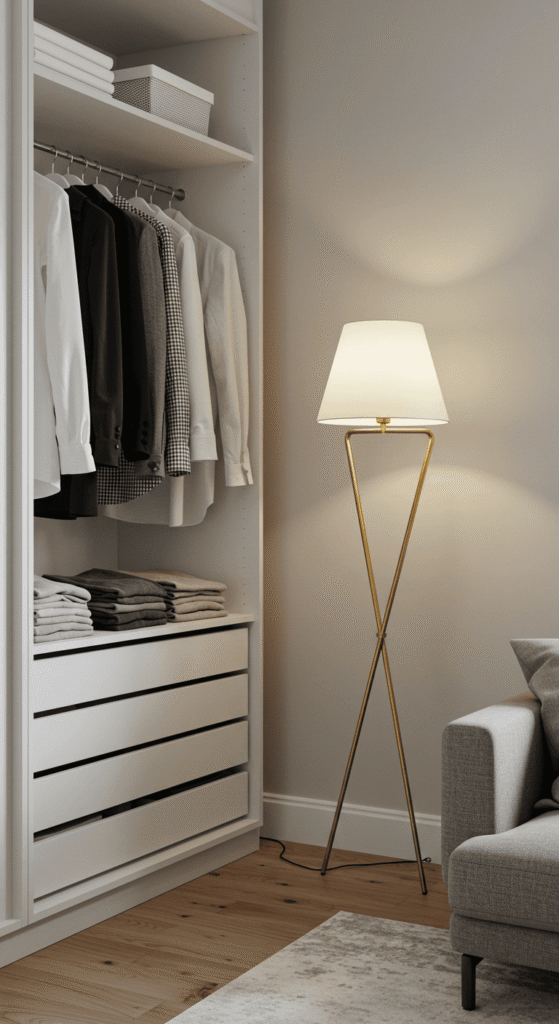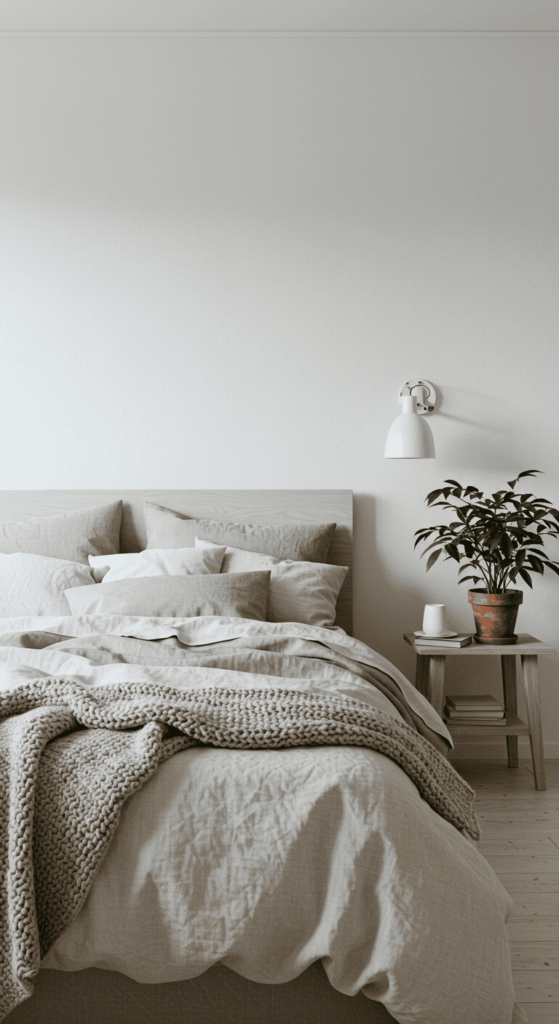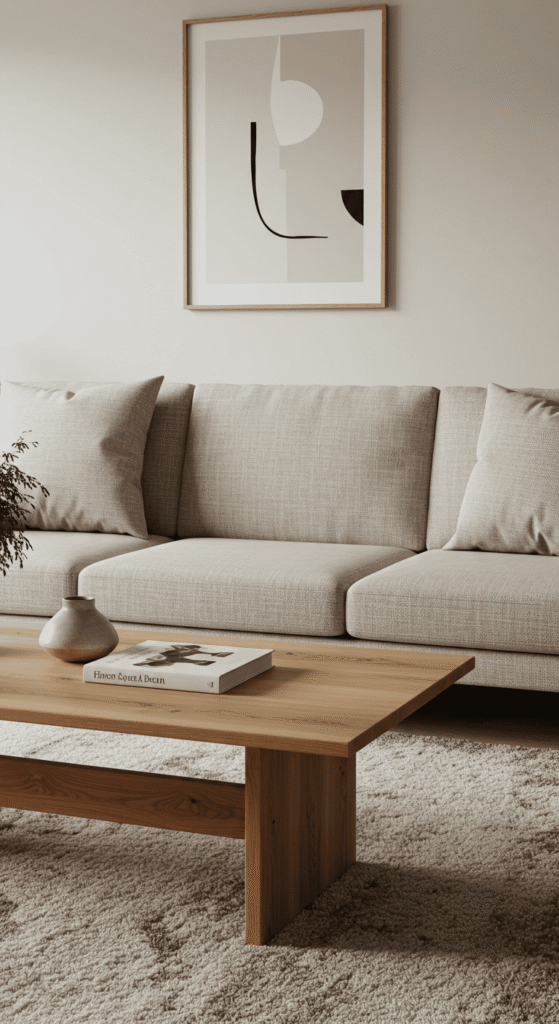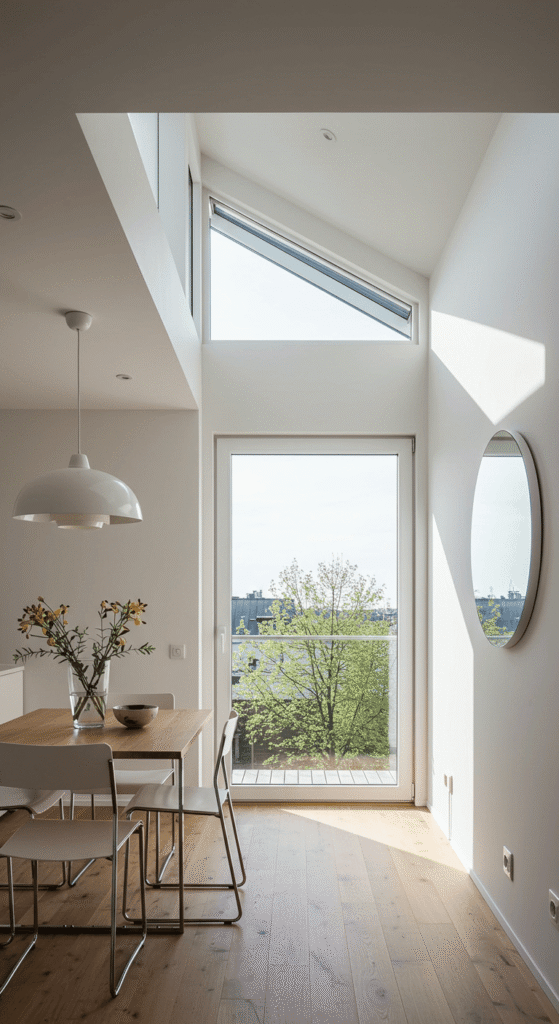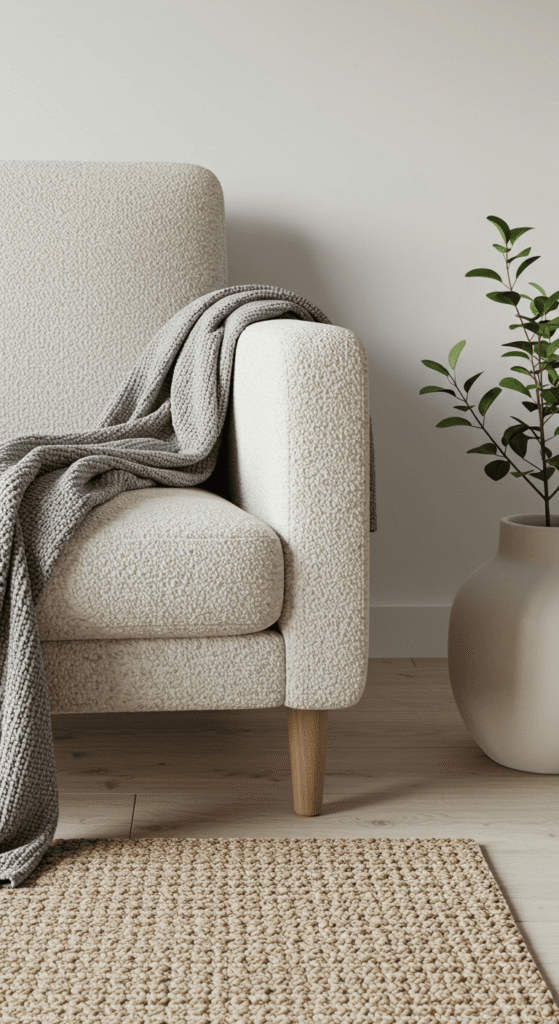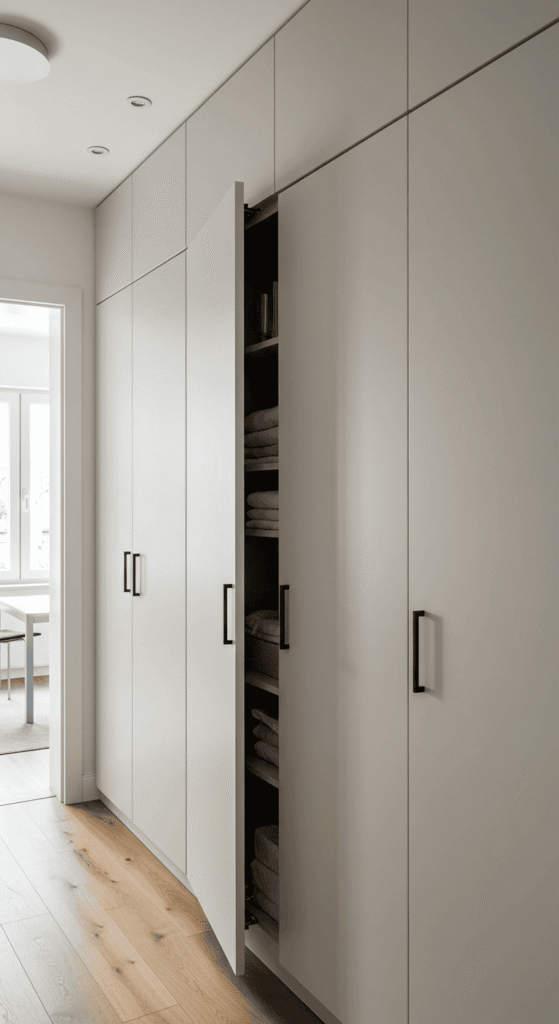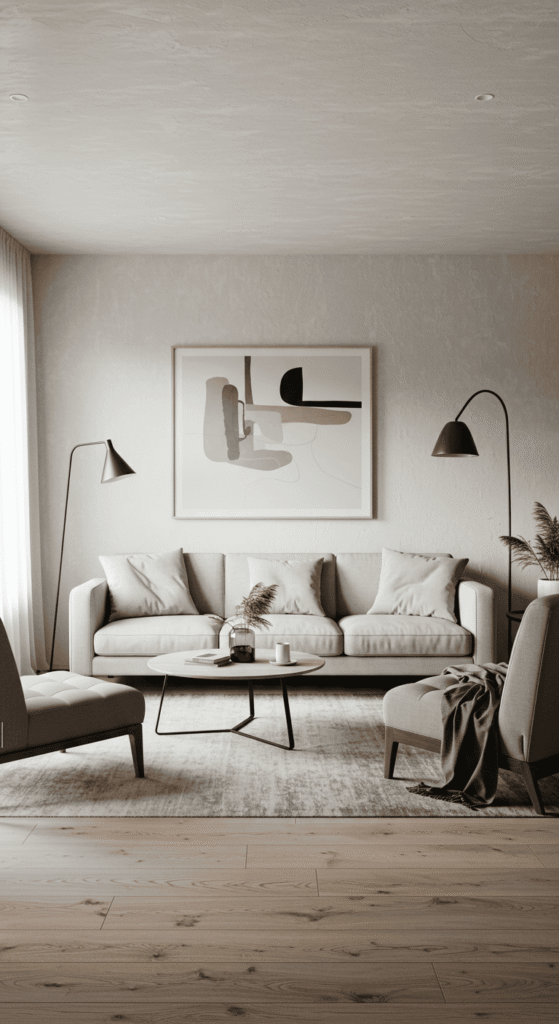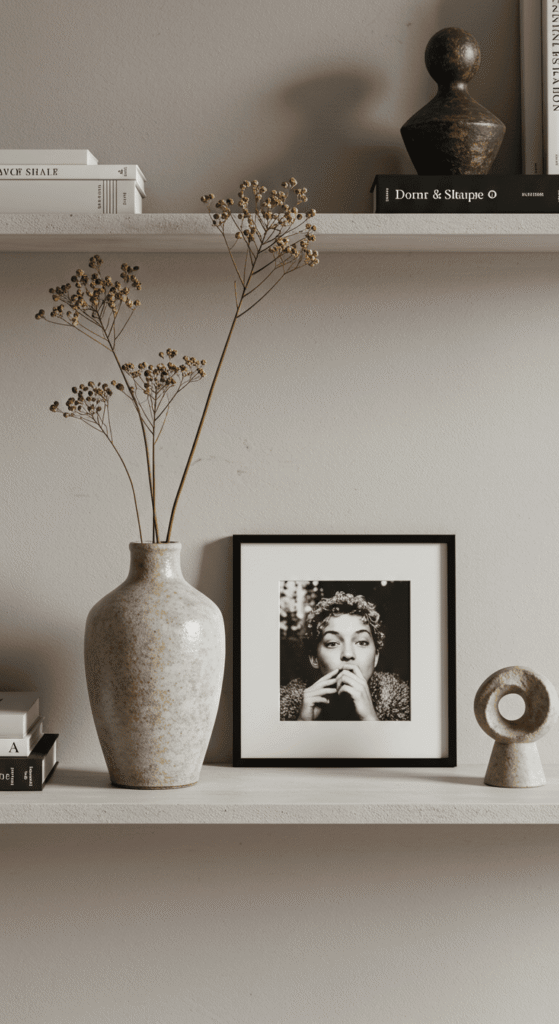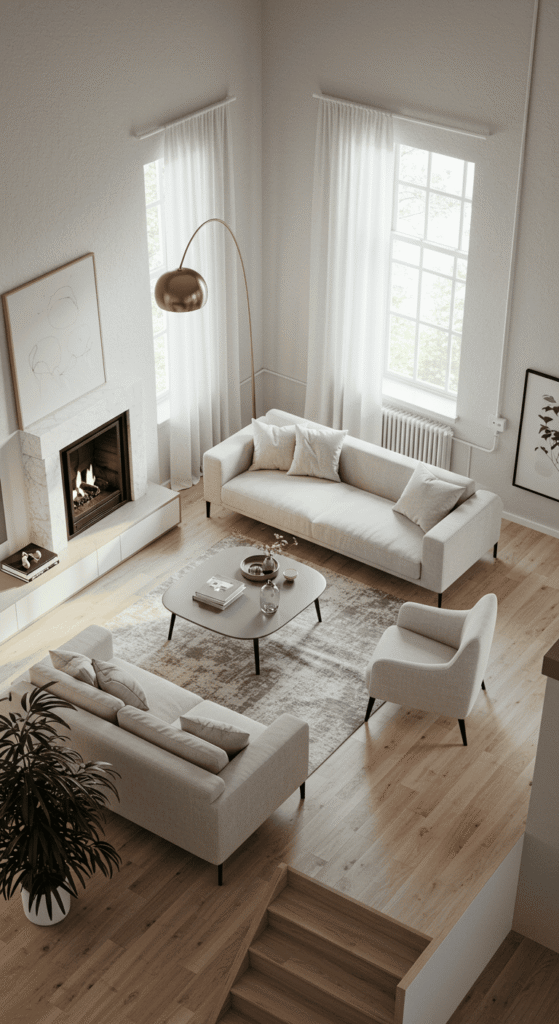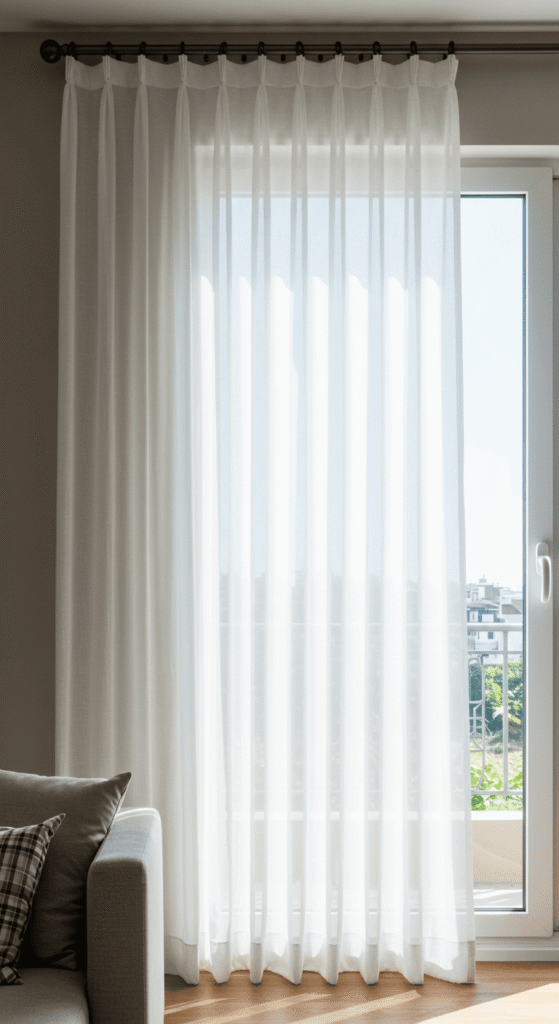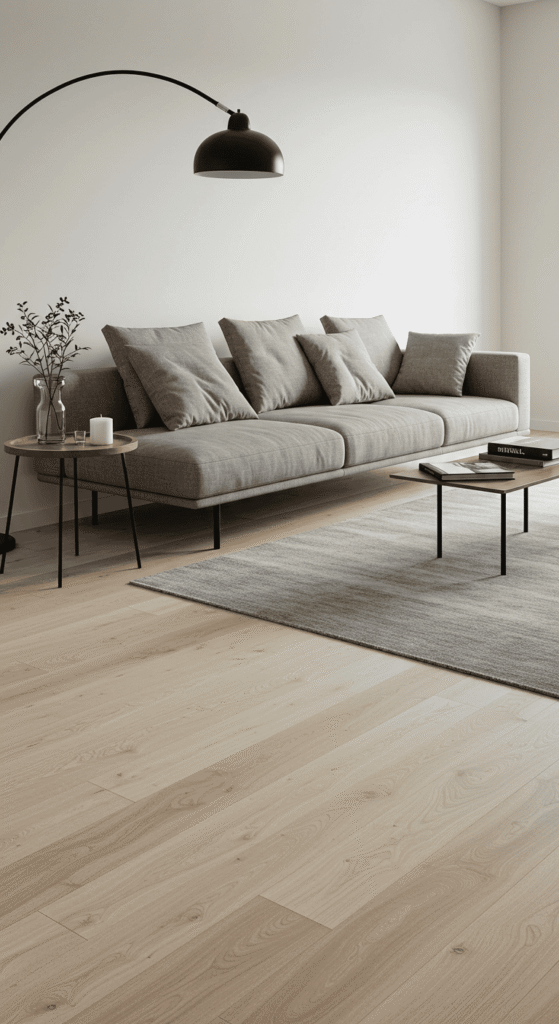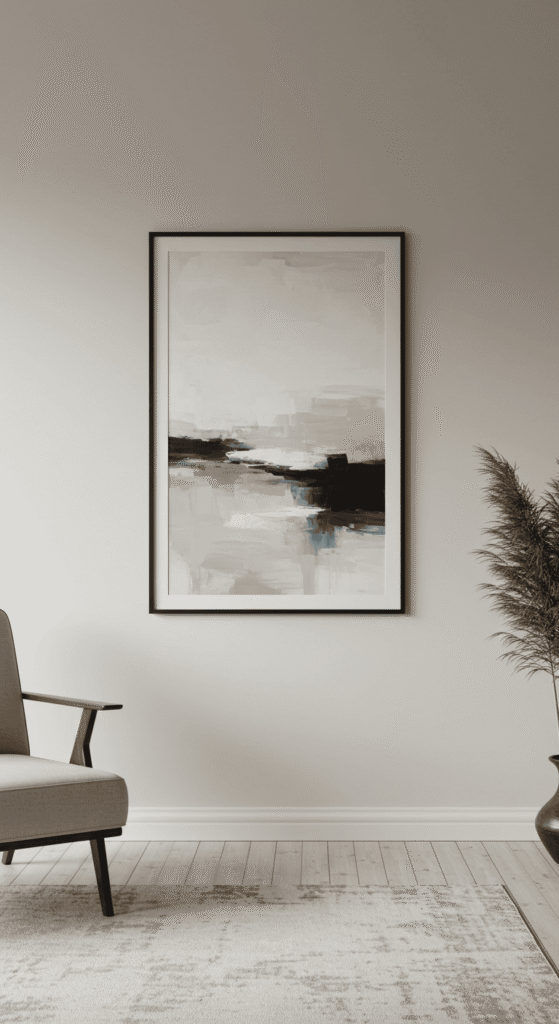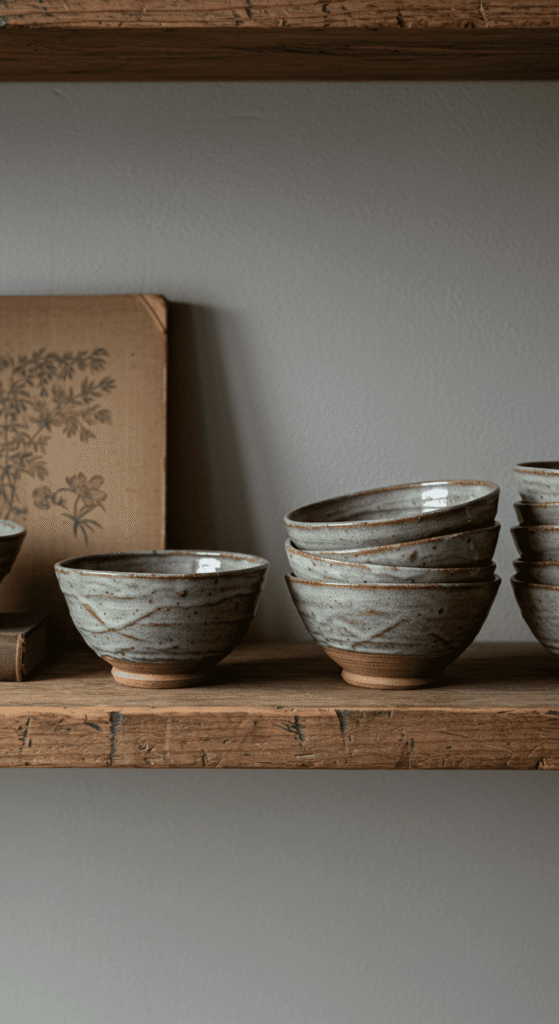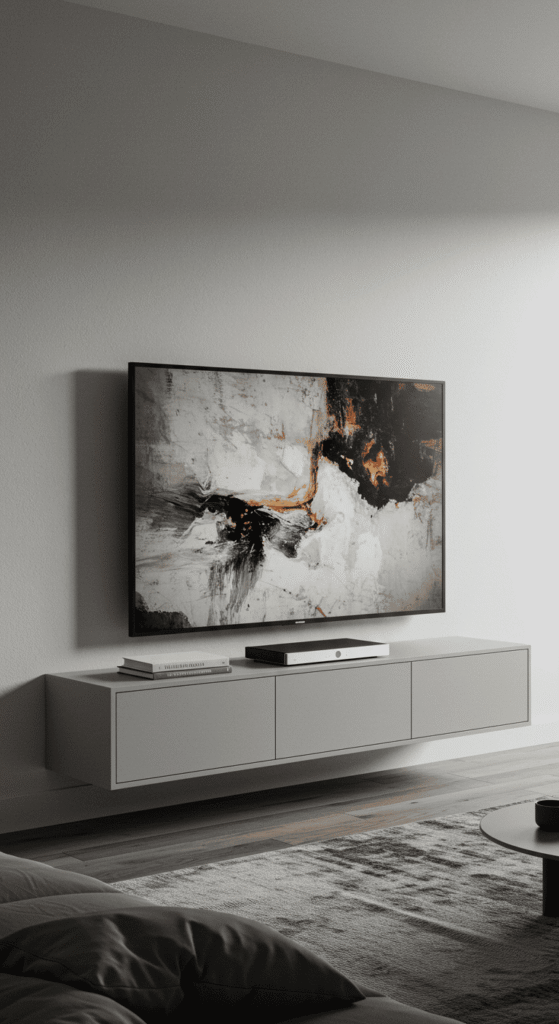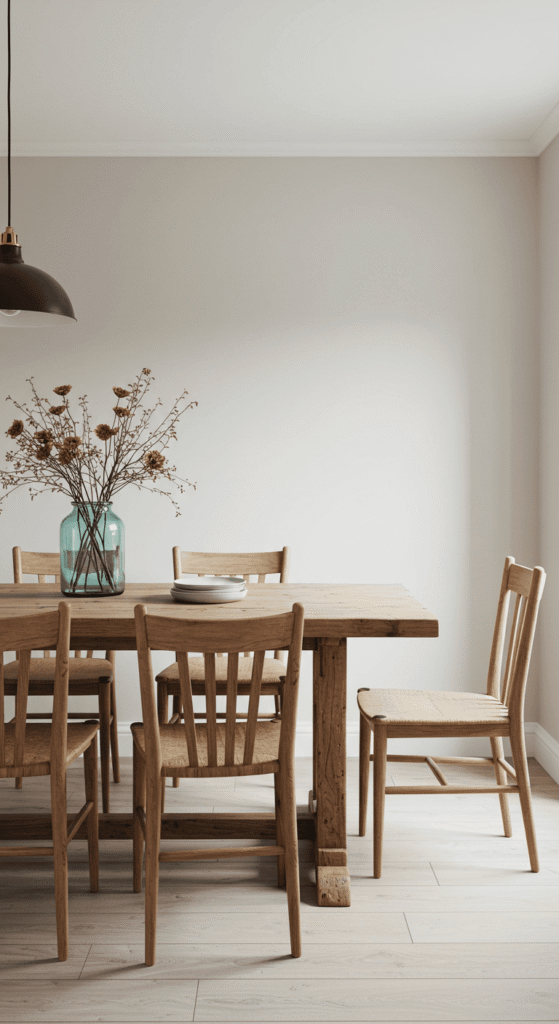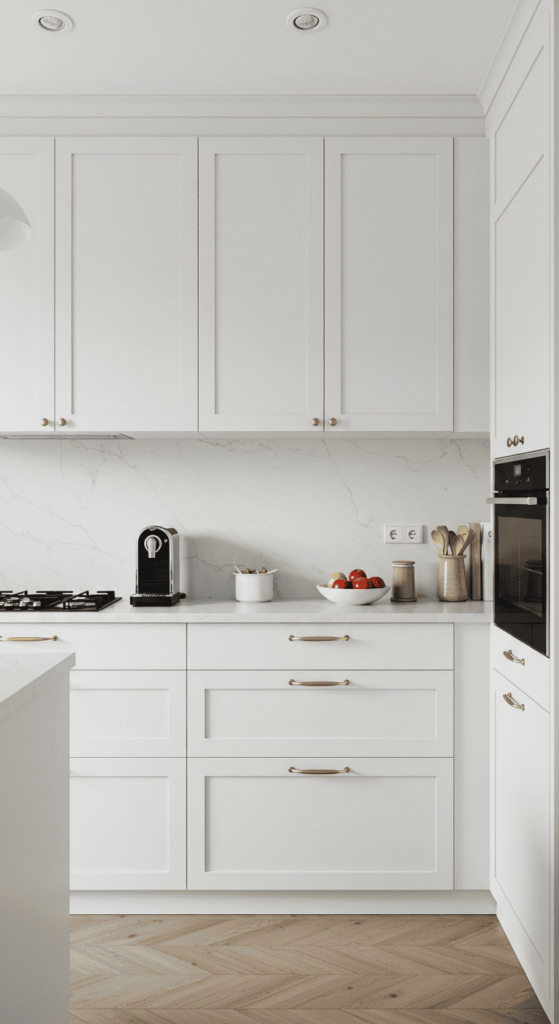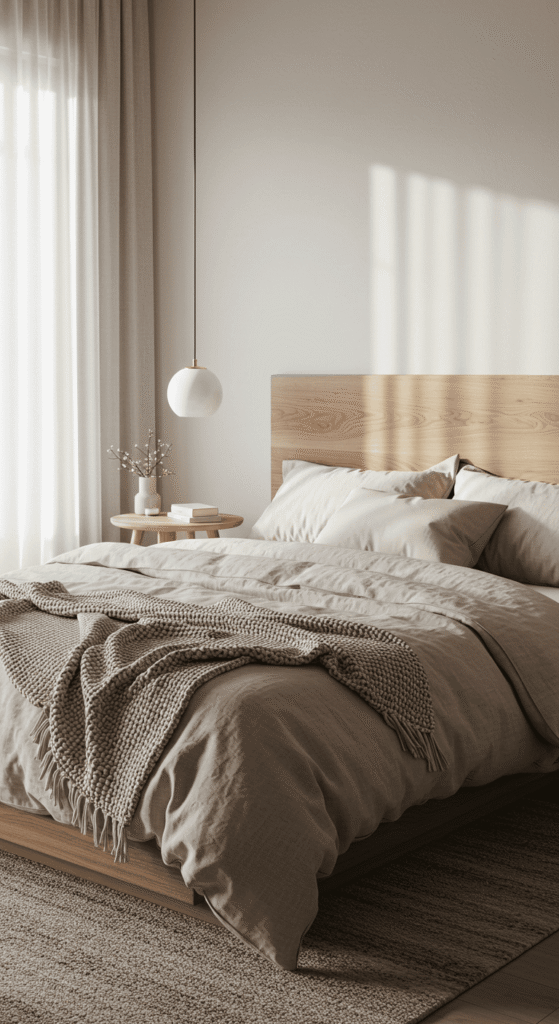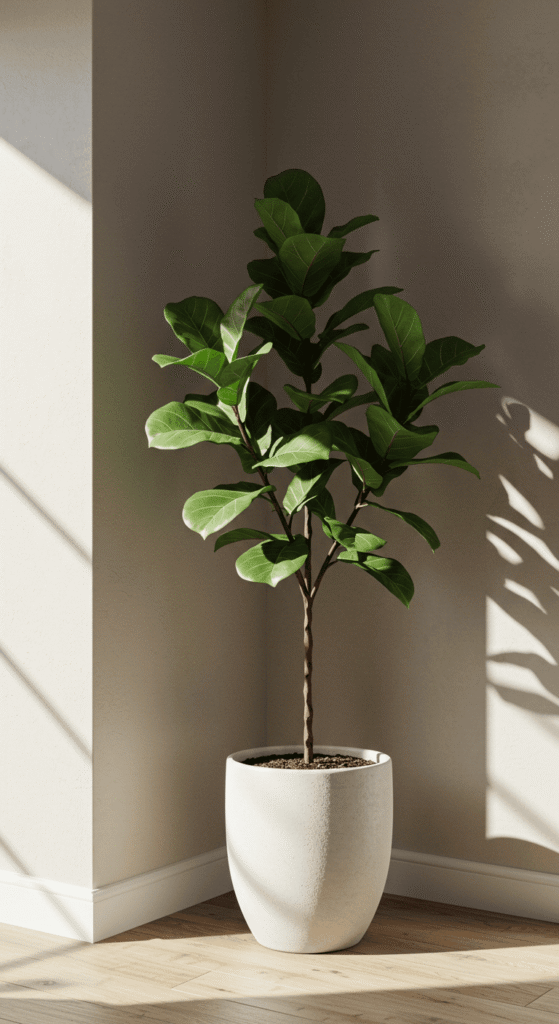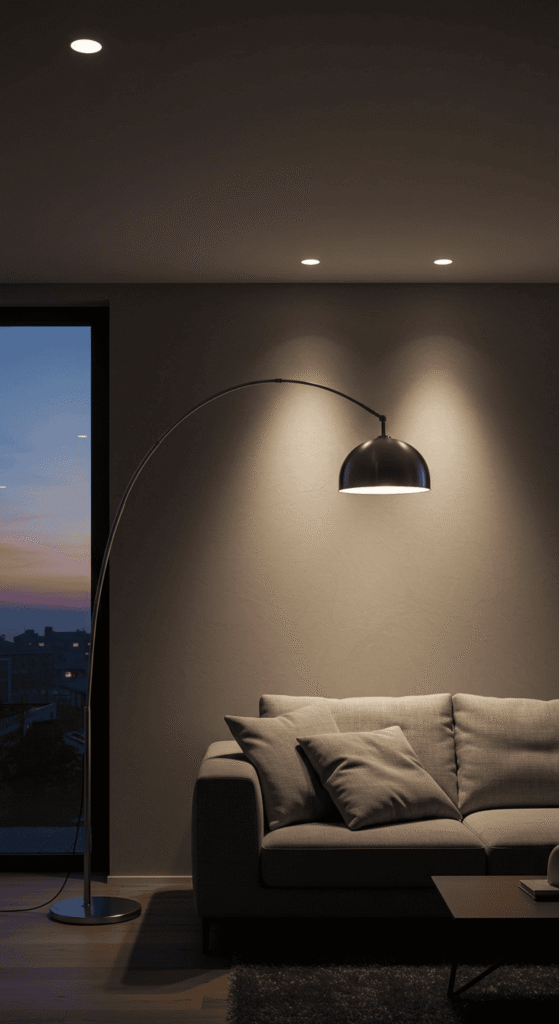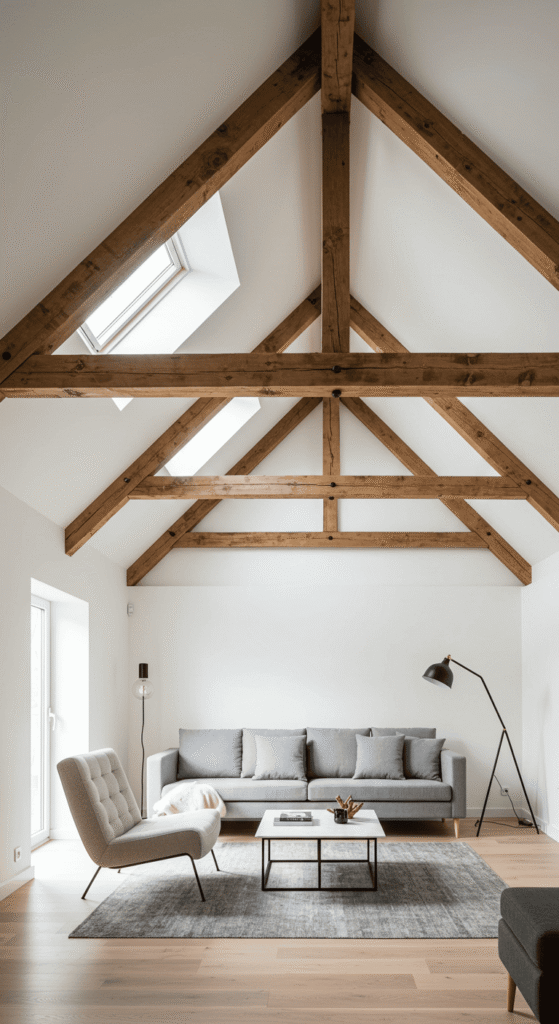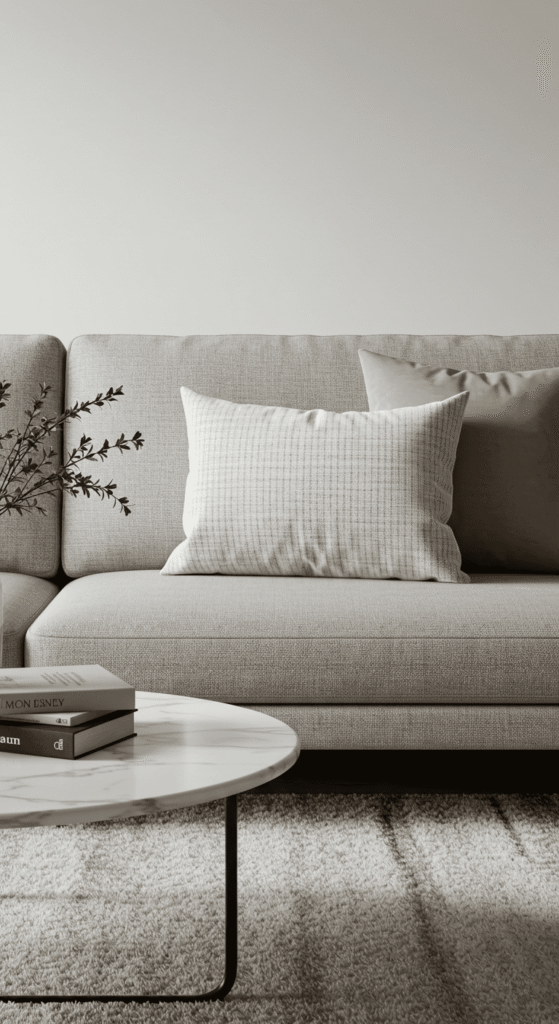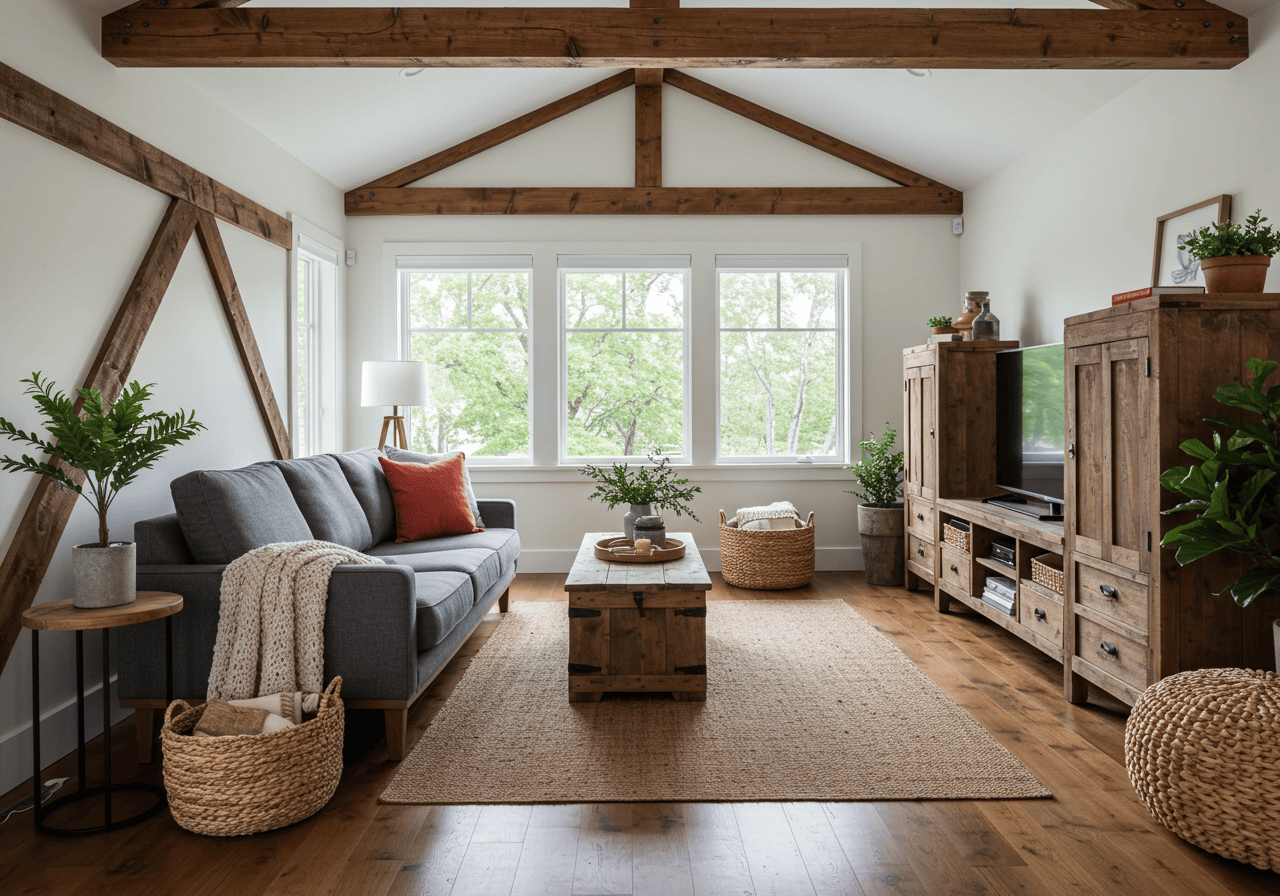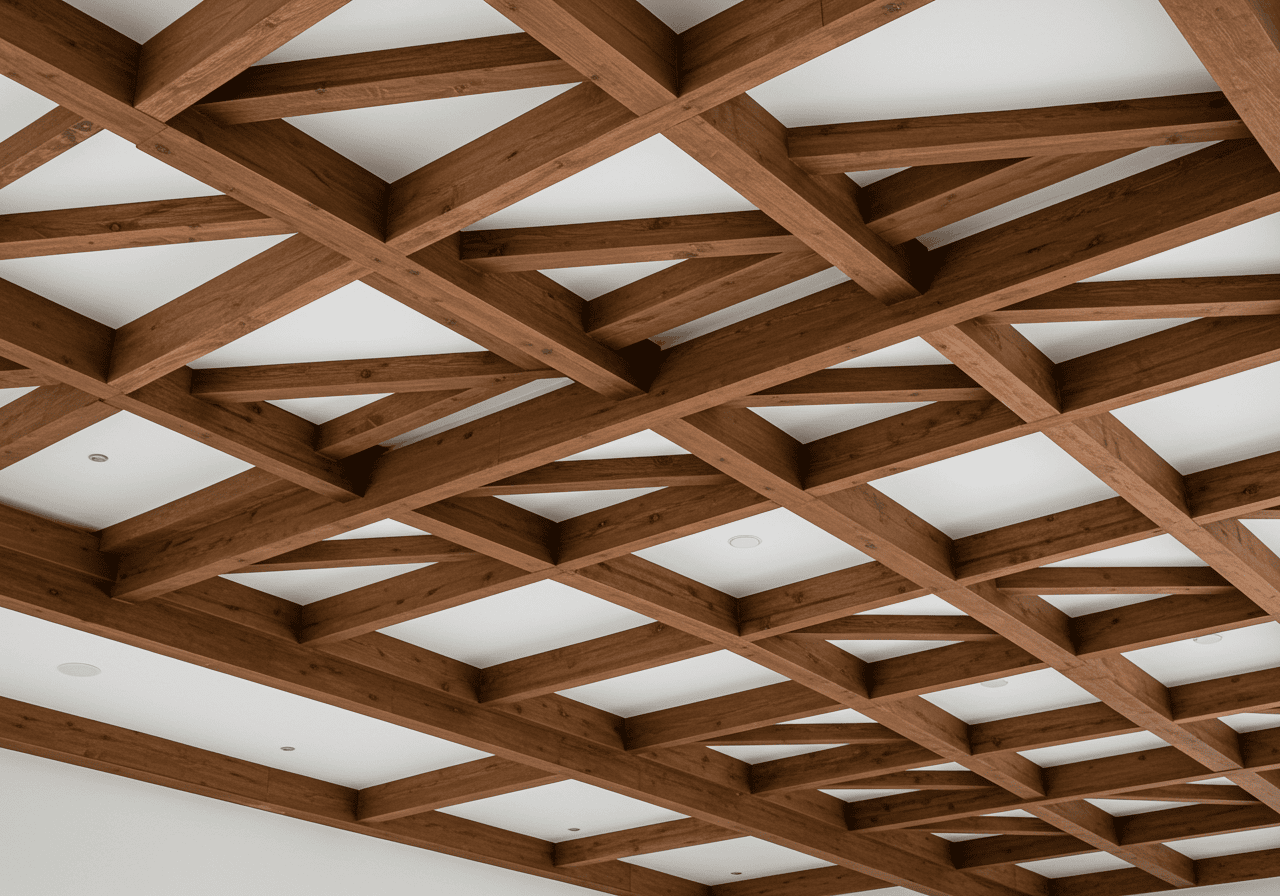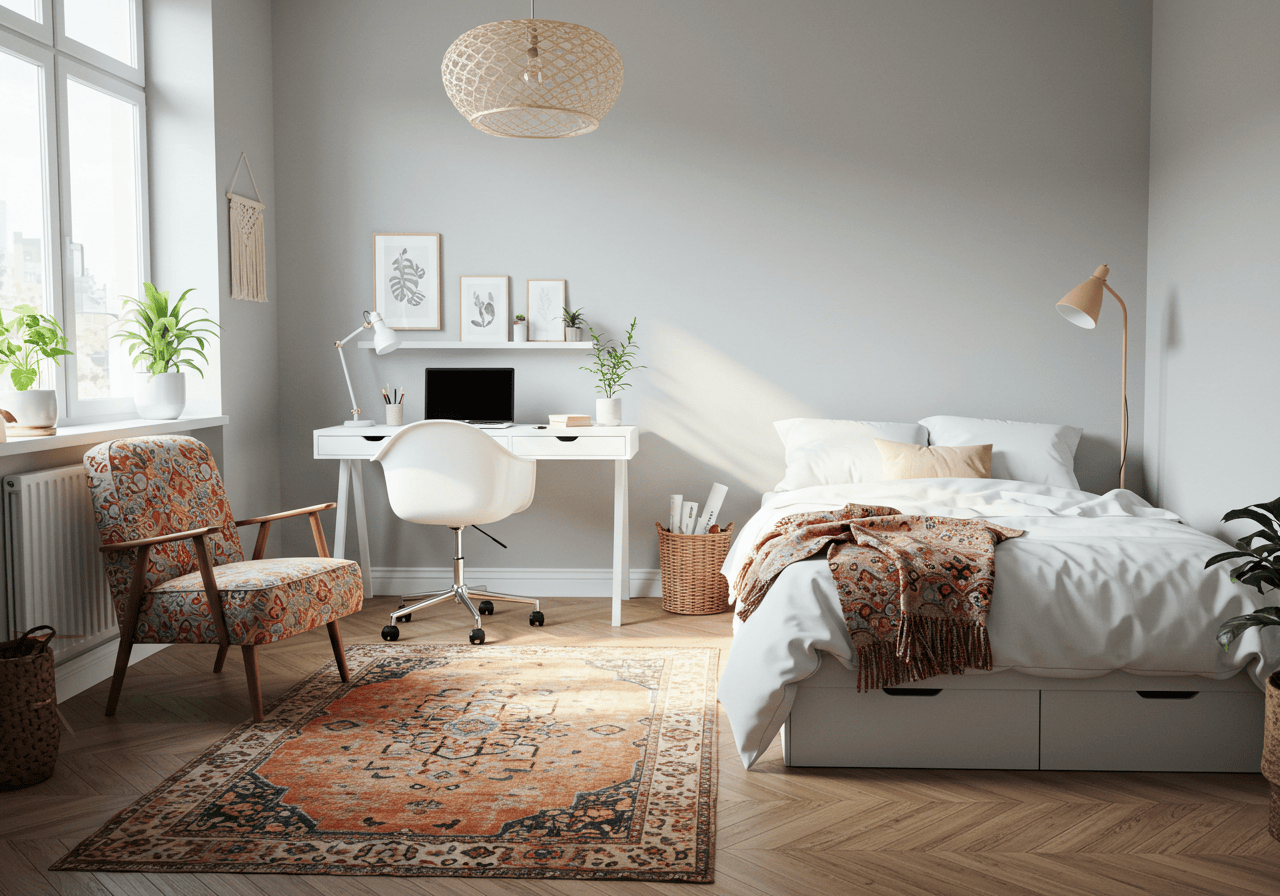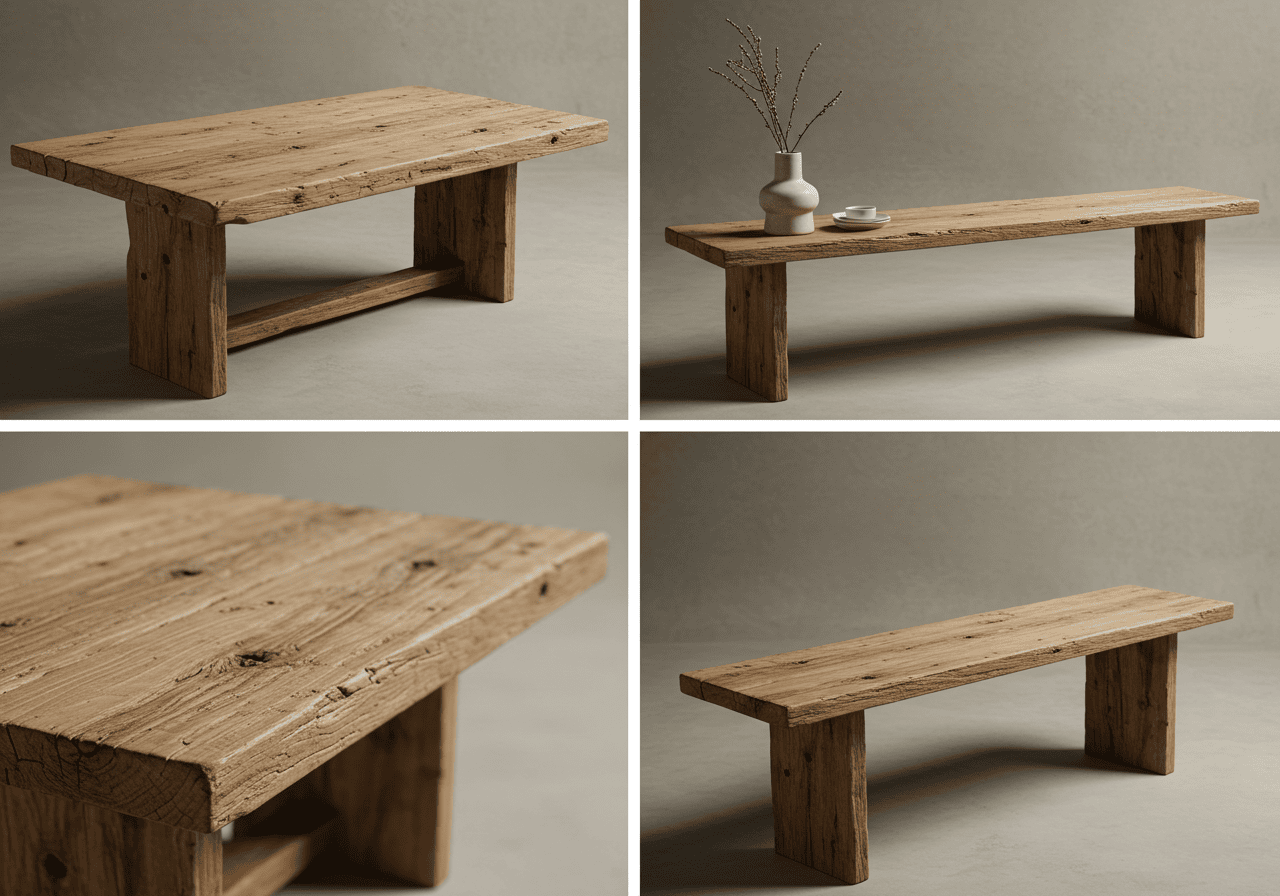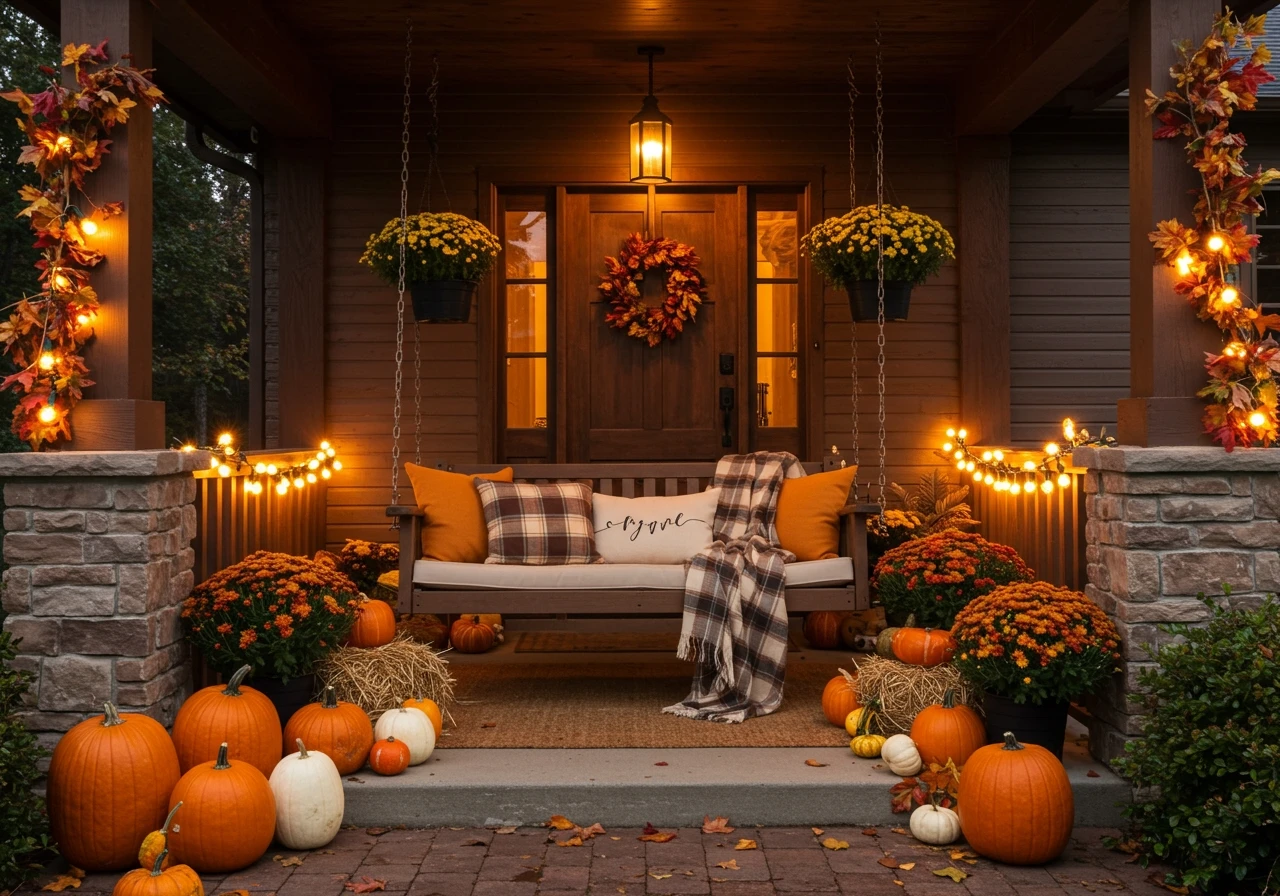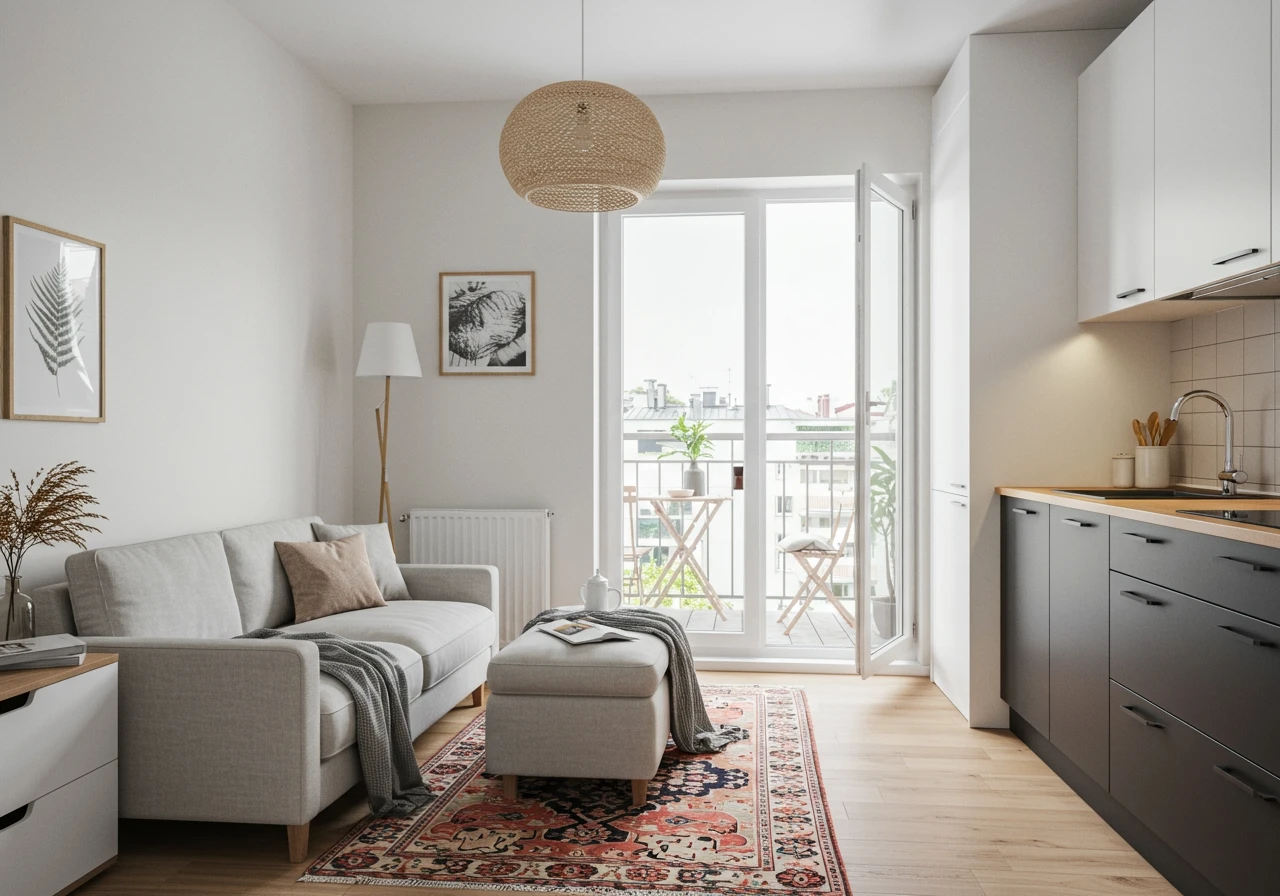Feeling overwhelmed by stuff? Do you dream of walking into a home that feels calm, airy, and effortlessly stylish? If so, you’re in the right place! Minimalistic interior design isn’t about stark, empty rooms or depriving yourself of personality. It’s about intentional living, curating spaces that breathe, and surrounding yourself only with things that add value and joy to your life.
Think of it as the ultimate home detox – a way to create a serene sanctuary where you can truly relax and recharge. Minimalist decor principles focus on clean lines, uncluttered spaces, a thoughtful color palette, and an emphasis on quality over quantity. The result? A timeless, sophisticated home that feels both luxurious and wonderfully livable.
Ready to embrace the “less is more” philosophy and transform your home? Let’s dive into some inspiring and practical minimalistic interior design ideas that will help you achieve that coveted sense of peace and order.
1. Embrace the Power of “Less is More” – The Decluttering Kickstart
This is the absolute cornerstone of any minimalistic interior design journey. Before you even think about new furniture or paint colors, you need to declutter. It might sound daunting, but the freedom you’ll feel afterward is incredibly rewarding!
- What it means: Systematically going through your belongings and letting go of items that no longer serve a purpose, don’t bring you joy, or simply add to the visual noise.
- Why it’s key for minimalism: A minimalist space is inherently an uncluttered space. By removing excess, you allow your chosen pieces to shine and create a more calming environment.
- Get started:
- Tackle one room, or even one category (like books or clothes), at a time to avoid overwhelm.
- Ask yourself: “Do I use this regularly? Do I truly love it? Would I buy it again today?”
- Be honest! It’s okay to let go. Consider donating, selling, or recycling items in good condition.
Expert Tip: Implement the “one in, one out” rule. For every new item that comes into your home, an old one must leave. This helps maintain a clutter-free environment long-term.
2. Master the Neutral Palette (with a Pop!)
Color plays a pivotal role in setting the mood of a room. In minimalist decor, neutral colors are your best friends, creating a serene and sophisticated backdrop.
- The go-to shades: Think whites, creams, beiges, soft grays, and even muted, earthy tones. These colors reflect light, making spaces feel larger and more open.
- Why they work: Neutrals provide a calming, cohesive foundation that doesn’t distract the eye. They evoke a sense of peace and simplicity, which is central to the minimalist ethos.
- Avoiding the “boring” trap: A neutral palette doesn’t have to be monotonous!
- Layer textures: Combine different materials like linen, wool, smooth cotton, light wood, and matte ceramics in similar neutral shades to add depth and interest.
- Subtle pops: Introduce a single, carefully chosen accent color through small decor items like a cushion, a piece of art, or a vase. Opt for muted shades like dusty blue, sage green, or terracotta rather than bright, jarring hues.
Expert Tip: When choosing whites, pay attention to their undertones (cool, warm, or true neutral) to ensure they harmonize with your lighting and other elements in the room. Test samples on your walls in different lights before committing.
3. Invest in Quality, Not Quantity: The Art of Intentional Furnishing
Minimalism champions the idea of owning fewer, better things. This is especially true when it comes to furniture. Instead of filling your home with trendy, disposable pieces, focus on acquiring high-quality items that are built to last and truly resonate with your style.
- The philosophy: Each piece of furniture should be functional, beautiful, and meaningful. It’s about conscious consumption and choosing items that will stand the test of time, both in terms of durability and design.
- What to look for:
- Clean lines and simple forms: Avoid overly ornate or fussy designs.
- Natural materials: Wood, metal, stone, and natural fibers often feature prominently in minimalist furniture.
- Functionality: Does it serve its purpose well? Can it perhaps serve multiple purposes? This is particularly crucial for making the most of smaller spaces, like in small apartment decorating.
Expert Tip: Consider multi-functional furniture to maximize utility and minimize clutter. An ottoman with hidden storage, a sofa bed for a guest room, or a console table that can double as a small desk are all smart choices for a minimalist home.
4. Let There Be Light: Maximizing Natural Illumination
Natural light is a minimalist designer’s secret weapon. It has the incredible ability to make any space feel larger, airier, and more inviting, all while highlighting the simplicity and beauty of your carefully chosen decor.
- Why it’s crucial: Abundant natural light enhances the clean aesthetic of minimalism, reduces the need for artificial lighting during the day (saving energy!), and has proven benefits for mood and well-being.
- How to maximize it:
- Keep windows unobstructed: Avoid heavy, dark drapery. Opt for sheer curtains, light blinds, or leave windows bare if privacy allows.
- Light-colored walls and surfaces: These will reflect light around the room, amplifying its effect.
- Strategic furniture placement: Ensure larger pieces don’t block windows or cast large shadows.
Expert Tip: Use mirrors strategically. A large, simply framed mirror placed opposite a window can dramatically increase the amount of natural light in a room and create an illusion of greater depth. This is a fantastic trick for any room, but especially effective in smaller areas or even a dedicated meditation room where a bright, calm atmosphere is desired.
5. Texture is Your Secret Weapon for Warmth and Depth
A common misconception about minimalistic interior design is that it can feel cold or clinical. The antidote? Texture! Layering various textures is key to adding warmth, visual interest, and a tactile quality to your space, all without adding clutter.
- Why it matters: In a room with a limited color palette and fewer objects, texture provides the necessary sensory richness. It invites touch and makes the space feel more inviting and cozy.
- How to incorporate it:
- Textiles: Think chunky knit throws, velvet cushions, linen curtains, faux fur rugs, or a nubby boucle armchair.
- Natural Materials: Smooth, cool marble; warm, grained wood; sleek metal; rough-hewn stone; or woven seagrass baskets.
- Wall Finishes: Consider textured wallpaper (in a subtle pattern or solid color), limewash paint, or even exposed brick if it suits your style.
Expert Tip: Don’t be afraid to mix contrasting textures. The interplay between a smooth, cool surface (like a polished concrete floor or a glass tabletop) and a soft, warm texture (like a wool rug or a linen sofa) creates a delightful and sophisticated dynamic. This approach works wonderfully in larger, open-plan spaces, such as those found in a loft apartment, where defining zones through texture can be very effective.
6. Smart Storage: Keep Clutter Hidden, Serenity Revealed
“A place for everything, and everything in its place.” This old adage is the mantra of minimalist decor. Effective storage solutions are non-negotiable if you want to maintain that serene, uncluttered look. The goal is to have ample space to tuck away everyday essentials, keeping surfaces clear and calm.
- The importance of concealment: Visual clutter is one of the biggest enemies of a minimalist aesthetic. Smart storage keeps the “stuff” of life out of sight but easily accessible.
- Clever storage ideas:
- Built-in wardrobes and cabinets: These offer seamless storage that blends into the walls.
- Furniture with hidden storage: Ottomans, beds with drawers underneath, coffee tables with lift-tops or shelves.
- Floating shelves (used sparingly): For a few curated display items, not for piling things up.
- Vertical space: Utilize tall, narrow shelving units or wall-mounted cabinets to draw the eye upward and maximize storage without taking up too much floor space – a great tip for studio apartment decor.
Expert Tip: Regularly declutter your storage spaces too! It’s easy for hidden areas to become new clutter zones. Schedule a quick “storage sort-out” every few months to ensure you’re only keeping what you truly need and love.
7. Embrace “Negative Space”: The Art of What’s Not There
In the world of design, negative space (or white space) refers to the empty areas around and between objects. In minimalistic interior design, negative space is just as important as the objects themselves. It gives elements room to breathe and allows the eye to rest.
- Why it’s powerful: Negative space prevents a room from feeling cramped or chaotic. It highlights the beauty of your chosen furniture and decor by giving them prominence and reducing visual competition.
- How to create it:
- Resist over-furnishing: Don’t feel the need to fill every corner or cover every wall.
- Space out your pieces: Allow ample room between furniture items.
- Keep surfaces clear: Limit the number of accessories on tables, shelves, and countertops. For instance, when considering coffee table decor ideas, opt for one or two impactful items rather than a collection of many small things.
Expert Tip: Think of negative space as a design element in itself. When arranging a room, consciously consider the “empty” areas. Ask yourself: “Does this layout feel balanced and airy, or is it starting to feel crowded?” Adjust accordingly until there’s a comfortable flow and visual ease.
8. Curate Your Decor: Every Piece Tells a Story (or Serves a Purpose)
Minimalism isn’t about having no decor; it’s about being highly selective. Each decorative item should be intentional, either bringing you immense joy, holding sentimental value, or serving a practical function in a beautiful way.
- The intention: Move away from impulse buys or filling spaces just for the sake of it. Instead, curate a collection of items that truly resonate with you and enhance the overall aesthetic.
- Choosing wisely:
- Art: A single, statement piece of art can have more impact than a gallery wall of smaller, disconnected items.
- Plants: Greenery adds life, color, and a touch of nature. Choose sculptural plants in simple pots.
- Personal treasures: Display a few cherished mementos, but be selective.
- Functional beauty: Think a beautifully designed teapot that you use daily for your own personal coffee bar ideas at home, or an elegant ceramic fruit bowl.
Expert Tip: Rotate your decor. If you have several beloved pieces but want to maintain a minimalist look, store some away and swap them out seasonally or whenever you fancy a change. This keeps your space feeling fresh without adding clutter.
9. Create Flow with Thoughtful Layouts: Space as a Luxury
Minimalism isn’t just about what’s in a room; it’s also about how you move through it. A well-thought-out layout that promotes easy circulation and an open feel is fundamental to minimalistic interior design. The goal is to create spaces that feel intuitive and unencumbered.
- What it means: Arranging furniture to create clear pathways and defined zones, ensuring that the room doesn’t feel cramped or awkward to navigate. It’s about respecting the “empty” space as much as the furnished space.
- Why it’s vital for minimalism: A cluttered layout equals a cluttered mind. By prioritizing flow, you enhance the sense of calm and order. Each piece should have a purpose in its placement, contributing to the room’s overall function and aesthetic.
- Achieving good flow:
- Consider traffic patterns: How do you naturally move through the room? Keep these paths clear.
- Scale furniture appropriately: Oversized furniture can quickly overwhelm a space and hinder flow, especially in smaller rooms.
- Group furniture for function: Create conversational groupings in living areas or efficient work triangles in kitchens.
- Leave breathing room: Don’t push all furniture against the walls. Sometimes, “floating” pieces can create a more dynamic and open feel.
Expert Tip: Before committing to a layout, try using painter’s tape on the floor to mark out where larger furniture pieces will go. This helps you visualize the space and traffic flow, preventing costly mistakes. This is especially useful when planning multi-functional areas like a bonus room ideas space that might serve as a home office and a relaxation zone.
10. The Understated Elegance of Simple Window Treatments
Windows are the eyes of your home, and how you dress them significantly impacts the overall minimalist feel. The key is simplicity, functionality, and maximizing natural light.
- The minimalist approach: Forget heavy, ornate drapes with fussy valances or complicated blinds. Think clean lines and light-enhancing materials.
- Why it complements minimalism: Simple window treatments don’t distract from the view (if you have one!) or the architectural features of the room. They contribute to the airy, uncluttered aesthetic.
- Best choices:
- Sheer curtains: Diffuse light beautifully, add a touch of softness, and provide a degree of privacy without blocking light. White or off-white sheers are classic.
- Simple roller blinds: Offer a clean, unobtrusive look when raised and provide privacy when lowered.
- Plain Roman shades: These offer a tailored look and can add a soft textural element when made from linen or cotton.
- Bare windows (if privacy allows): In some settings, especially with beautiful window frames or stunning views, no treatment is the most minimalist choice.
Expert Tip: For bedrooms or media rooms where light control is essential, consider a double rod system. Use a sheer curtain on the inner rod for daytime softness and a blackout roller blind or a simple, solid-colored blackout curtain on the outer rod for nighttime.
11. “Bare” is Beautiful: Celebrating Simple Floors
Flooring is a vast canvas in any room, and in minimalist decor, it’s an opportunity to lay a foundation of simplicity and calm. Uncluttered, clean-lined flooring options enhance the sense of space and light.
- The ideal: Smooth, continuous surfaces that don’t have busy patterns or too many grout lines.
- Why it works: Simple flooring creates a visually quiet base that allows other elements in the room to stand out. It’s also generally easier to clean and maintain, contributing to an overall sense of order.
- Popular minimalist choices:
- Polished concrete: Industrial-chic, durable, and seamless.
- Light-toned hardwood or engineered wood: Adds warmth and natural texture. Think wide planks and matte finishes.
- Large-format tiles: In materials like porcelain or natural stone, with minimal grout lines.
- High-quality laminate or vinyl: Modern options can beautifully mimic wood or stone with a seamless look.
- The role of rugs: While “bare” is often beautiful, a simple, well-chosen rug can define a zone, add warmth, and introduce texture. Opt for solid colors, subtle geometric patterns, or natural fiber rugs (like jute or sisal) in neutral tones. Avoid overly plush or patterned rugs that can feel visually heavy.
Expert Tip: When choosing flooring that runs through multiple rooms or an open-plan space, opt for a single, continuous material if possible. This creates a cohesive flow and makes the entire area feel larger and more unified.
12. Art as a Focal Point, Not a Collection
In minimalistic interior design, art isn’t about filling wall space; it’s about making a deliberate statement. A single, impactful piece can often say more than a dozen smaller ones. The focus is on quality, personal connection, and how the art interacts with the space around it.
- The principle: Choose art that resonates deeply and complements the room’s serene atmosphere. Less is often more.
- How to select and display:
- Scale matters: A large, bold piece can anchor a room and become a captivating focal point. In smaller spaces, a thoughtfully chosen medium-sized piece can work well.
- Consider the subject: Abstract art, minimalist photography, or line drawings often suit the aesthetic, but ultimately, choose what you love.
- Simple framing: Opt for clean, minimal frames (or no frame at all for canvas pieces) that don’t compete with the artwork.
- Strategic placement: Give the artwork breathing room. Don’t crowd it with other wall decor. Consider its relationship to furniture and lighting.
Expert Tip: Don’t just think about walls. A beautiful sculptural piece placed thoughtfully on a console table or even on the floor can act as art and add a three-dimensional element to your minimalist space. This can be particularly effective when setting up an inviting space for visitors, such as in your guest room ideas, where one strong art piece can make the room feel special.
13. The Beauty of Imperfection: Wabi-Sabi Meets Minimalism
While minimalism often emphasizes clean lines and order, incorporating elements of Wabi-Sabi – the Japanese aesthetic of finding beauty in imperfection and transience – can add profound depth and warmth to your space. It’s about appreciating the natural, the handmade, and the perfectly imperfect.
- What it means: Embracing items that show signs of age, wear, or natural irregularities. Think handcrafted ceramics with slight variations, a weathered wooden bench, or linen textiles that soften and crease with use.
- Why it enriches minimalism: Wabi-Sabi injects soul and character, preventing a minimalist space from feeling sterile or mass-produced. It celebrates authenticity and the story behind objects.
- Incorporating Wabi-Sabi elements:
- Handmade decor: Opt for artisan-made pottery, handwoven textiles, or unique wooden objects.
- Natural materials in their raw state: Unfinished wood, rustic stone, or tarnished metals.
- Embrace asymmetry: Not everything needs to be perfectly balanced or symmetrical.
- Patina and age: Don’t shy away from pieces that show a bit of history.
Expert Tip: Look for beauty in simplicity and authenticity. A single, beautifully gnarled branch in a simple vase can be more impactful than an elaborate floral arrangement. Focus on pieces that feel grounded and tell a quiet story.
14. Tech Integration: Sleek and Seamless
In our modern lives, technology is ubiquitous. The challenge in minimalistic interior design is to integrate it seamlessly, so it enhances our lives without visually cluttering our serene spaces.
- The goal: Make technology blend in or disappear, rather than dominate the room.
- Smart integration strategies:
- Concealed wiring: Invest in solutions to hide cables and cords (e.g., cable organizers, in-wall wiring, furniture with built-in cable management).
- Frame TVs: Televisions that display art when not in use can blend beautifully into a gallery wall or stand alone as a subtle design element.
- Smart home devices with minimalist design: Choose speakers, thermostats, and lighting controls with sleek, unobtrusive aesthetics.
- Furniture with built-in tech: Some modern furniture pieces offer integrated charging ports or speakers.
Expert Tip: When designing a media unit or entertainment center, opt for closed storage to hide consoles, media players, and accessories. A simple, floating console can look incredibly chic and keep the focus off the tech itself.
15. Sustainable Minimalism: Conscious Choices for a Calmer Home (and Planet)
Minimalism and sustainability are natural partners. The “less is more” philosophy inherently encourages more conscious consumption, focusing on quality, durability, and materials that are kind to the environment. Embracing sustainable practices within your minimalistic interior design not only elevates your space but also aligns your home with your values.
- The connection: Choosing fewer, better things means less waste. Opting for natural, renewable, or recycled materials reduces your environmental footprint. Supporting ethical brands contributes to a more sustainable economy.
- How to practice sustainable minimalism:
- Choose natural & renewable materials: Think bamboo, cork, reclaimed wood, organic cotton, linen, wool, and recycled glass or metal.
- Invest in pre-loved or vintage pieces: Secondhand furniture and decor can add unique character and prevent items from ending up in landfills. Look for timeless designs.
- Prioritize quality and craftsmanship: Well-made items last longer, reducing the need for replacement.
- Support ethical and local brands: Seek out companies transparent about their sourcing and production methods.
- DIY and upcycle: Get creative! Sometimes an old piece just needs a little love (and perhaps a coat of non-toxic paint) to become a minimalist gem.
Expert Tip: Before buying new, always ask yourself: “Do I truly need this? Is there a more sustainable alternative? Can I find this secondhand?” This mindful approach will guide you toward a more eco-conscious and beautifully minimalist home. For instance, when considering pieces like those for your coffee table decor ideas, look for items made from recycled glass or sustainably harvested wood.
16. Minimalist Kitchens: Functionality Meets Sleek Design
The kitchen is often the heart of the home, and a minimalist approach can make it an incredibly efficient, calm, and beautiful space to cook and gather. Think clean surfaces, smart storage, and an absence of countertop clutter.
- Core principles:
- Clear countertops: Store away small appliances, utensil crocks, and miscellaneous items.
- Integrated appliances: Appliances that blend seamlessly with cabinetry (e.g., panel-ready dishwashers and refrigerators) create a sleek look.
- Handleless cabinets or simple hardware: Contributes to clean lines.
- Neutral color palette: Whites, grays, and natural wood tones are popular.
- Why it’s a game-changer: A minimalist kitchen is easier to clean, feels more spacious, and makes finding what you need effortless. It turns a purely functional space into a serene culinary oasis. This can even inspire you to dedicate a small corner to your very own coffee bar ideas without it feeling crowded.
Expert Tip: Invest in good quality drawer organizers and cabinet inserts. These allow you to store items efficiently and out of sight, keeping those countertops beautifully clear. Think about how you use your kitchen and organize accordingly – items used most frequently should be most accessible.
17. Serene Sleeping Sanctuaries: The Minimalist Bedroom
Your bedroom should be the ultimate retreat – a place for rest, rejuvenation, and peace. Applying minimalistic interior design principles here can transform it into a true sanctuary, free from distractions and conducive to deep relaxation.
- The essence: A clutter-free environment, soothing colors, comfortable yet simple furnishings, and an emphasis on quality sleep.
- Creating the calm:
- Limited furniture: A bed, bedside tables, and perhaps a dresser or a simple chair are often all that’s needed. Avoid overcrowding the room.
- Calming color palette: Soft neutrals, muted blues, or gentle greens promote tranquility.
- Quality bedding: Invest in comfortable, high-quality sheets, duvets, and pillows in natural, breathable fabrics like linen or cotton. Texture here is key for coziness.
- Hidden storage: Utilize under-bed storage or sleek wardrobes to keep clothing and clutter out of sight.
- Blackout window treatments: Essential for promoting good sleep by blocking out unwanted light.
Expert Tip: Keep technology out of the bedroom, or at least out of sight. The bedroom should be a screen-free zone as much as possible to encourage better sleep hygiene and a more restful atmosphere. If you must have a TV, consider a smaller one or a solution where it can be concealed. This is particularly important if your bedroom also doubles as a quiet space, perhaps similar to the focused intent of a meditation room.
18. The Power of Green: Plants as Living Decor
In a minimalist setting, plants do more than just add a touch of nature; they act as living sculptures, bringing organic shapes, gentle color, and a breath of fresh air to an otherwise streamlined space. They are the perfect “accessory” because they are both beautiful and beneficial.
- Why plants fit minimalism:
- Natural beauty: They introduce organic forms that soften clean lines.
- Air purification: Many plants help improve indoor air quality.
- A touch of life: They prevent a space from feeling too stark or static.
- Choosing and styling plants:
- “Less is more” applies here too: Opt for a few well-chosen, healthy plants rather than a jungle.
- Sculptural varieties: Consider plants with interesting leaf shapes or growth patterns, like a Fiddle Leaf Fig, Snake Plant, Monstera, or a delicate String of Pearls.
- Simple pots: Choose planters in neutral colors (white, black, grey, terracotta) and simple shapes that complement the plant without competing with it.
Expert Tip: Consider the light conditions in your home when selecting plants. Choosing plants that will thrive in your specific environment means less fuss and healthier, more beautiful greenery. Don’t be afraid to go big with a single, statement floor plant in a larger room.
19. Mindful Lighting: Creating Ambience and Function
Lighting is a powerful tool in any interior design scheme, but in minimalist decor, it plays a crucial role in shaping the atmosphere and highlighting the simplicity of the space. The goal is to have layered, functional, and aesthetically pleasing lighting.
- Layered approach:
- Ambient lighting: Provides overall illumination (e.g., recessed lights, simple ceiling fixtures).
- Task lighting: Focused light for specific activities (e.g., under-cabinet lights in the kitchen, a desk lamp in a home office area, a reading lamp by a chair).
- Accent lighting: Highlights architectural features or specific objects like artwork (e.g., spotlights, picture lights).
- Minimalist fixture styles: Look for fixtures with clean lines, simple geometric shapes, and unobtrusive designs. Materials like matte black metal, brushed brass, or simple glass often work well.
- The importance of dimmers: Installing dimmers allows you to control the intensity of light and adjust the mood of the room, from bright and functional to soft and relaxing.
Expert Tip: Don’t overlook the color temperature of your light bulbs. For a warm, inviting minimalist space, opt for warmer white bulbs (around 2700K-3000K). Cooler whites can sometimes feel too clinical, though they can be appropriate for task areas.
20. The “No-Decor” Decor: Architectural Features as Stars
Sometimes, the most impactful minimalist statements are made by letting the architecture of the space speak for itself. If you’re lucky enough to have interesting architectural details, highlight them rather than covering them up with excessive decoration.
- What to feature:
- Exposed beams: Add rustic charm or industrial edge.
- Beautiful window frames or mouldings: Celebrate classic details.
- Exposed brick walls: Offer texture and character.
- High ceilings or interesting rooflines: Emphasize vertical space.
- A striking staircase: Can be a sculptural element in itself.
- How to let them shine: Keep surrounding decor simple and uncluttered. Use a neutral color palette on walls to avoid competing with the feature. Strategic lighting can also draw attention to these elements. This is particularly relevant if you’re working with unique spaces like a loft apartment where industrial features might be prominent.
Expert Tip: If your home lacks distinct architectural features, you can create a similar effect by investing in one or two high-quality, “architectural” pieces of furniture or lighting that have a strong, sculptural presence and can act as a focal point in their own right.
21. Quiet Patterns & Subtle Details: Adding Interest Without Overwhelm
While bold, busy patterns are generally a no-go in minimalist decor, this doesn’t mean your space has to be devoid of all pattern or intricate detail. The key is subtlety, scale, and how the pattern interacts with the overall serene environment. “Quiet” patterns can add a layer of sophisticated interest without creating visual clutter.
- What “quiet patterns” entail:
- Tone-on-tone designs: Patterns created using different shades of the same color (e.g., a white fabric with a slightly raised white geometric pattern).
- Subtle geometrics: Think fine pinstripes, delicate chevrons, or small-scale, unobtrusive grids.
- Textural patterns: Materials like ribbed glass, fluted wood panels, or a finely woven textile can create a pattern through their texture rather than color contrast.
- Natural patterns: The grain of wood, the veining in marble, or the gentle mottling of linen are all beautiful, organic patterns.
- How to use them effectively:
- Sparsely: Introduce one or two subtle patterns in a room, perhaps on a cushion, a throw, a rug, or a single accent wall treatment.
- Balance with solids: Ensure patterned elements are surrounded by plenty of neutral, solid surfaces to maintain a sense of calm.
- Consider scale: In smaller spaces, very small, subtle patterns often work best. Larger, more open rooms can sometimes handle a slightly more noticeable (but still quiet) pattern. This is a great tip for small apartment decorating where every detail counts.
Expert Tip: When in doubt, err on the side of subtlety. The pattern should feel like a gentle whisper in the room, not a loud shout. It’s there to add a touch of depth and refinement, not to be the main attraction.
We hope these 21 ideas have sparked your imagination and empowered you to embark on your own minimalistic design journey. Remember, creating a serene and stylish home is about making conscious choices that lead to a more intentional and joyful way of living. Happy decorating!


